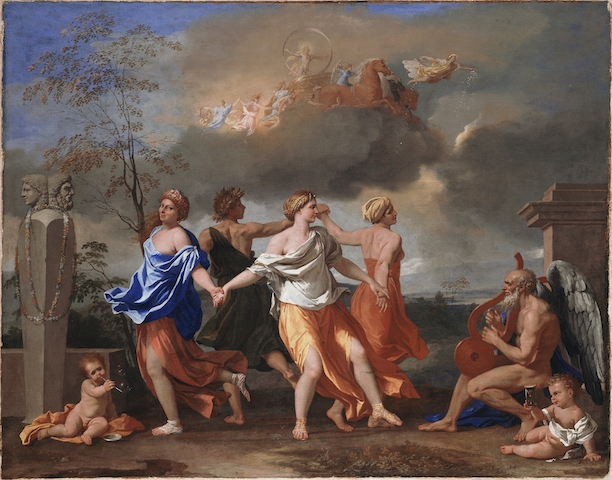One day in 1975, Commander Gerald Lambourne of Scotland Yard’s Fingerprint Department was called upon to investigate an object brought to him by Sir Anthony Blunt, Surveyor of the Queen’s Pictures. Writing much later in Fingerprint Whorld, the international journal of The Fingerprint Society, Lambourne asserted, in the compelling prose for which fingerprint specialists are known, that ‘it is a brave person who can say with all honesty and sincerity that a standard which is generally recognised as excellent, correct or acceptable is not required for the ultimate in personal identification’.
The Blunt object in question was a recently restored painting by Nicolas Poussin owned by the Wallace Collection. Prior to its acquisition in 1845 by Richard Seymour-Conway, the 4th Marquess of Hertford, whose private collection formed the basis of that museum’s holdings, A Dance to the Music of Time (1634–36) had only two previous owners: the family of its commissioning patron, Giulio Rospigliosi, later Pope Clement IX, and, after travelling to France in 1806, Cardinal Joseph Fesch, uncle of Napoleon Bonaparte. Following the cardinal’s death, and the sale of his collection in Rome, Seymour- Conway returned to London and hung his purchase in his house on Manchester Square, where it remains today. The painting would leave its own mark on British cultural history when Anthony Powell took its title for his famous series of novels.
Gerald Lambourne had been instrumental in collecting the fingerprints that were used to convict members of the Great Train Robbery gang in 1964, most famously by dusting the robbers’ Monopoly set. Given his experience of unusual cases, the police commander may not have been surprised when Blunt unwrapped a painting on his desk in Scotland Yard. A little over 80 centimetres high by about a metre wide, Poussin’s composition shows four figures in flowing robes dancing in a circle, holding hands and facing outwards. Other characters observe from the sidelines: a nude old man with wings plucking a harp; a couple of babies playing with small symbolic objects; and fragments of classical architecture, including a marble post topped with two busts facing in opposite directions. Above all this, and far away in the distance, is another troupe of figures dancing behind a horse-drawn chariot, on top of a bank of dark clouds.
‘The cleaning of the painting’, wrote Blunt in The Burlington Magazine in 1976, ‘has provided the occasion for examining a technical feature which has long puzzled students of Poussin.’ Lambourne’s examination confirmed that the painting was, as Blunt and his colleagues suspected, stamped across its entire surface with fingerprints made in the very early stages of the painting’s manufacture. Lefthand thumbprints, to be precise, pressed into the wet priming layer, and visible underneath the allegorical scene Poussin painted, like an eddying stream. Were they Poussin’s own prints? ‘It would be unwise to be too affirmative,’ was Blunt’s opinion. He certainly never used that technique anywhere else. ‘It would be unwise to be too affirmative.’ Case closed.
‘The exact meaning of the composition is not known.’ This, from the Wallace Collection’s website, is the standard line on this and many other paintings by Poussin. Putting aside its implied assumption that ‘exact meanings’ might be knowable (or desirable) in any work of art, this kind of text performs important work in the service of academic employment, maintaining a steady flow of symposia, catalogue essays and book reviews by keeping closure at bay. It is, in that sense, very Blunt. The former director of the Courtauld Institute of Art, and author of a definitive monograph on Poussin, had himself benefited from the constructive ambiguity of the artist’s paintings, much as he had benefited from the same characteristic in the British and Soviet secret services, for whom he worked as a spy for 20 years, a fact revealed four years after his meeting with Lambourne. This Poussin was remade in his own image, a refracted self-portrait: a still and silent point at the centre of a whirl of scholars and connoisseurs. ‘I who make a profession of mute things,’ as Poussin had described himself in a rare statement on his own work. It has Blunt’s thumbprints all over it.
The dancing figures in Poussin’s painting have been made, over the years, to represent a variety of abstract concepts: the four seasons, say, or Poverty, Labour, Wealth and Luxury. Few readings of the painting are intuitive, aside from the entry-level symbolism of the hourglass or the baby blowing bubbles, but every reading is a reading, a treatment of the painting as substitute text, like a foreign-language film in need of subtitling. Its classical friezelike arrangement is very like a written sentence, and its title is almost a complete sentence too, despite not being Poussin’s original (it was given to the painting in the early twentieth century, and its first title is lost). In his article, Blunt pictures a circle of cognoscenti in Rospigliosi’s palazzo (which might as well be in the Courtauld, for that matter: only the costumes change) gathered around the latest acquisition and parsing its meanings. All the while, the painting watches itself being watched through a female face turned smilingly to the viewer, like the camera on a laptop. The circle is closed.
What Poussin, or whoever’s thumb made those impressions, had in mind by pressing their body’s weight into the work’s surface seems beyond the guesswork of art historians. Perhaps it was a simple technical strategy, as has been suggested: some experimental way of building a ground. But the history of commentary – from his biographer Giovanni Pietro Bellori to André Félibien to the unrecorded interpretations of visitors to the various palaces in which the painting hung – can occlude as well as elucidate. The disjunction between the painting’s surface and the descriptive marks of the brush splits its register. The body’s trace speaks too. Sometimes, it’s wise to be affirmative.
From the October 2019 issue of ArtReview
